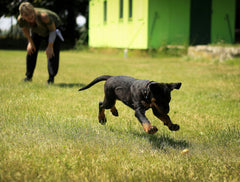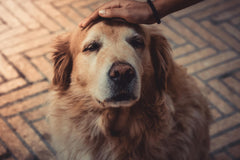
All dogs are different. They will behave differently, and you can see that in households with various pets. For example, I went over to a friend's house the other day, and my friend has two Shiba Inus.
Even though they spend all their time together, they showed different behaviors: one came to greet me after a short while, whereas the second one kept going in circles far from me. One was curious, and one was scared.
As dog owners, we sometimes feel powerless because our dogs seem uncontrollable and will not respond to basic commands such as "sit" and "lay down."
These dogs may get distracted when they see someone or hear noises, and it is hard to calm them down. However, after speaking to a few dog trainers, I can assure you that every dog is trainable. It may require a different approach and probably some patience, but all dogs are trainable.
How to know if your dog is being unreasonable
The first thing you need to understand is that dog behaviors are very different from human behaviors. Therefore, what may seem logical to you may seem weird to your dog: "Why do they want me to do that?"
The main principle behind dog training is repetition because it may take a while to learn a new behavior. When something happens just once or twice, it is hard for your dog to understand that they received the treat because they laid down.
If your dog gets overly excited when there are distractions around, they are not being unreasonable. Instead, follow the tips below to correct any unwanted behavior and encourage the desired behavior.
Forget punishment
I would say that most people are aware of this by now. Since it is easy to get frustrated as a dog owner, we sometimes lash out or reprimand our dog. All dog trainers agree that this can lead to avoidance, freezing, or aggression.
When your dog does something you don't like:
- Ignore what he is doing. Giving him attention may unintentionally reward him for that behavior.
- Redirect him to something else, or positive behavior, and reward him for that with playing, petting, or a treat.
Get your dog more exercise
We want to rule out that your dog is being disobedient because he lacks exercise. Try to walk your dog and play with him before you have any serious training sessions.
Getting your dogs more exercise may fix more issues than you believe. If they have pent-up energy, they may start acting like they are uncontrollable.
Start small and slow
Depending on your dog's current training, you may want to start small. For example, if your current issue is having your dog be out of control, you may want to wait to teach them how to obey your commands.
Instead, you can use my Smallest Rewardable Action method. This is how it works:
- What is the desired behavior? For example, you want your dog to sit down when saying "sit."
- What are the steps your dog needs to take to do this correctly? Your dog needs to: be calm, stay in place, look at you, and then sit.
- Going back to the list we just made, what is the smallest action you can reward? It would be "be calm."
- "Be calm" is the Smallest Rewardable Action.
I want you to understand that when you say "sit" as if it were just one action, it is a series of steps that may be hard to understand for your dog.
I recommend choosing the Smallest Rewardable Action and starting with that. You can still tell your dog "sit," but start rewarding that even if they don't understand what they need to do.
It is not a bad place for many uncontrollable dogs to start to reward them for being calm.
As a reward, you may want to play with them, pet them, or give them a treat.
Control the environment
Start training your dog in a distraction-free environment. This may be your kitchen or living room after removing any toys.
Then, once you get the desired behavior, you may start to add distractions:
- choose a different room, or even go outside
- ask your spouse or friend to come in during the training session
- place some toys your dog likes to play with near you
Similarly to building up the desired behavior (from "being calm" to "sitting down," for example), you will need to build up the environment.
If you do this correctly, you will be able to demonstrate your dog's training even when new people come over to your place.
Be consistent
There are two main mistakes people make when training their dogs.
The first one is that they tend only to do it once a day. Remember how I said earlier that repetition is critical in dog training?
If you are serious about training your dog, you should consider doing it a few times a day. For example, it may be once or twice before leaving for work and when coming home or throughout the day.
Your dog needs repetition to understand the association between your command, his action, and reward.
The other mistake you may make is being inconsistent in your commands, actions, and rewards. If other people live in your household, they may use the same commands as you but react entirely differently. For example, they may use the command and not reward your dog even though they were "being calm."
Get everyone on the same page and start small. You may focus on the Smallest Rewardable Action first and tell everyone, "please don't ask anything else from him."
Also, make sure that everyone knows how to say the command and reward accordingly.
Final thoughts
Dogs may seem uncontrollable, but they are not. They are all different, though, and you will want to change your approach if what you are doing is not working. But, on the other hand, if it is working, even just a little, take that as your cue that dog training requires patience and small steps.
If you enjoyed reading this and would like to receive more tips in your inbox, subscribe below!




